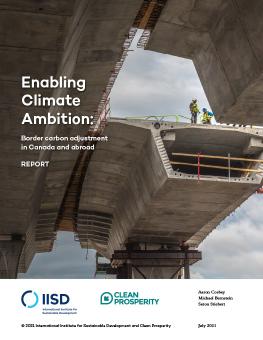
Enabling Climate Ambition: Border carbon adjustment in Canada and abroad
Canada’s ambitious climate policies are necessary to get us to net-zero by 2050, but if other countries don’t take similar actions, it will mean trouble for Canadian sectors such as steel, cement, fertilizers, and chemicals, whose emissions might simply be transferred to unregulated foreign competitors. Like other countries that are now working to implement protections, Canada needs to think about tools like border carbon adjustment (BCA) that aim to impose a carbon price on imports.
-
With Canada’s carbon price legislated to rise to CAD 170/tonne by 2030, we urgently need to design protections to ensure that our energy-intensive trade-exposed sectors achieve real emissions reductions, as opposed to seeing emissions simply transferred to unregulated foreign competitors.
-
Border carbon adjustment (BCA) will be a reality in the European Union (where it’s known as CBAM) by 2023, and the United States and United Kingdom intend to adopt similar systems. Any country with climate ambition will need to seriously consider following suit.
-
But BCA is devilishly complex, politically explosive, potentially illegal under trade rules, and would have to be adapted to Canada’s unique climate pricing regime. It’s imperative to start thinking in depth about how to get it right.
As climate ambition ramps up in Canada and around the world, one of the key challenges governments face is how to impose meaningful carbon prices on domestic industries when not all trading partners are similarly ambitious. In countries that are pursuing ambitious climate policies, there has been increasing interest in an instrument that could help enable that ambition: border carbon adjustment (BCA). BCA aims to ensure that imports face the same carbon price faced by domestic producers.
But BCA is devilishly complex, politically explosive, potentially illegal under trade rules, and would have to be adapted to Canada’s unique climate pricing regime. So Canadian policy-makers need to start thinking now about what such a regime might look like here.
This report surveys eight design elements and makes specific recommendations for the shape of a Canadian BCA. The report also explores how Canada should react to emerging BCA schemes in major trading partners such as the EU and United States, and how its own scheme might accommodate climate policies in those countries.
Participating experts
You might also be interested in
Carbon and Controversy: Why we need global cooperation on BCAs
Ambitious climate action and concerns about economic competitiveness and fair burden sharing require a collaborative discussion, not trade wars.
A Guide for the Concerned: Guidance on the elaboration and implementation of border carbon adjustment
What Can Least Developed Countries and Other Climate Vulnerable Countries Expect from The EU Carbon Border Adjustment Mechanism (CBAM)?
This briefing looks at the upcoming EU Commission proposal for a carbon border adjustment mechanism and its impact on climate vulnerable countries.
Carbon border adjustments are back in the spotlight
Canadian Finance Minister Chrystia Freeland’s recently released mandate letter will keep her busy for the foreseeable future.